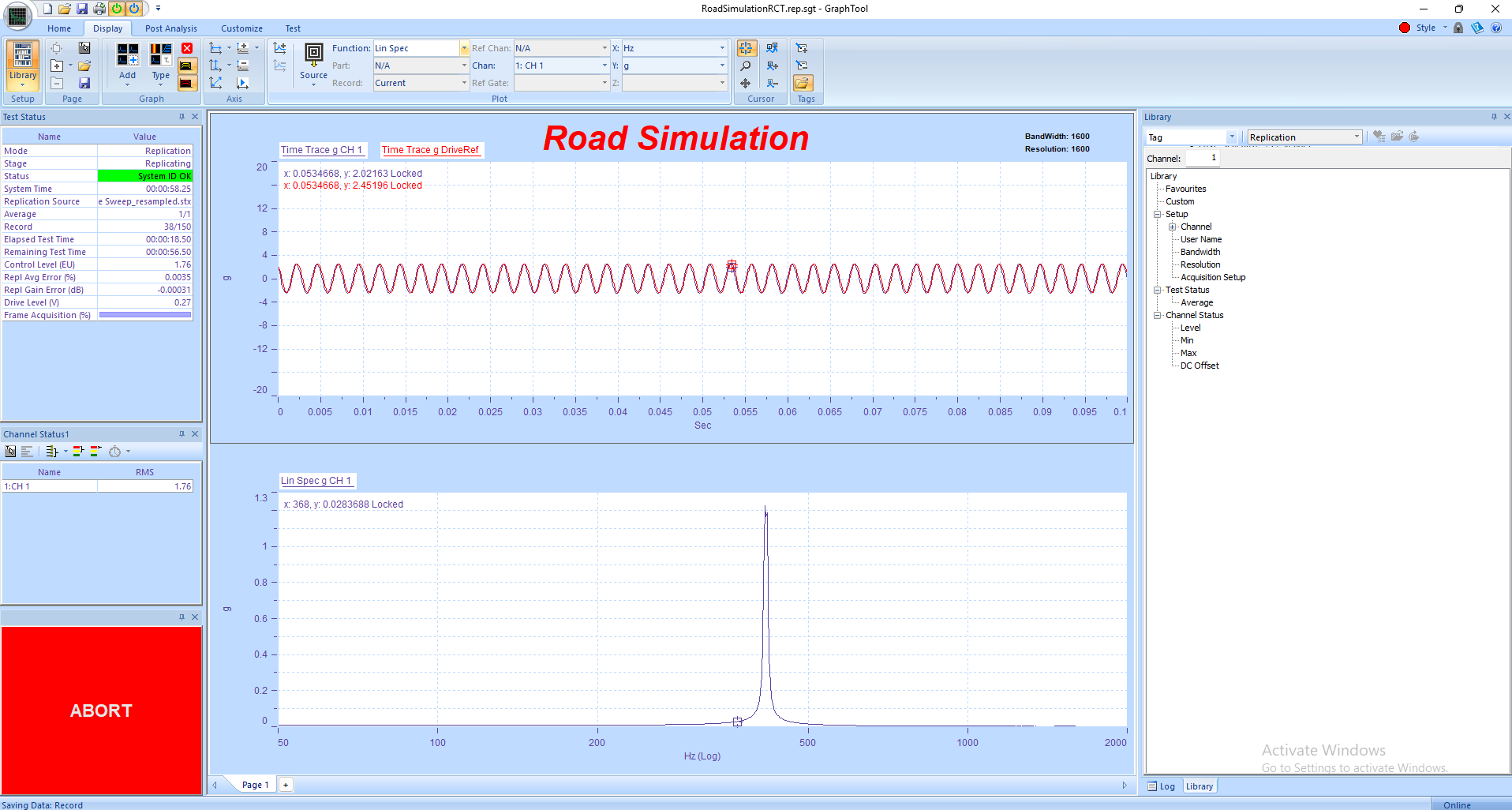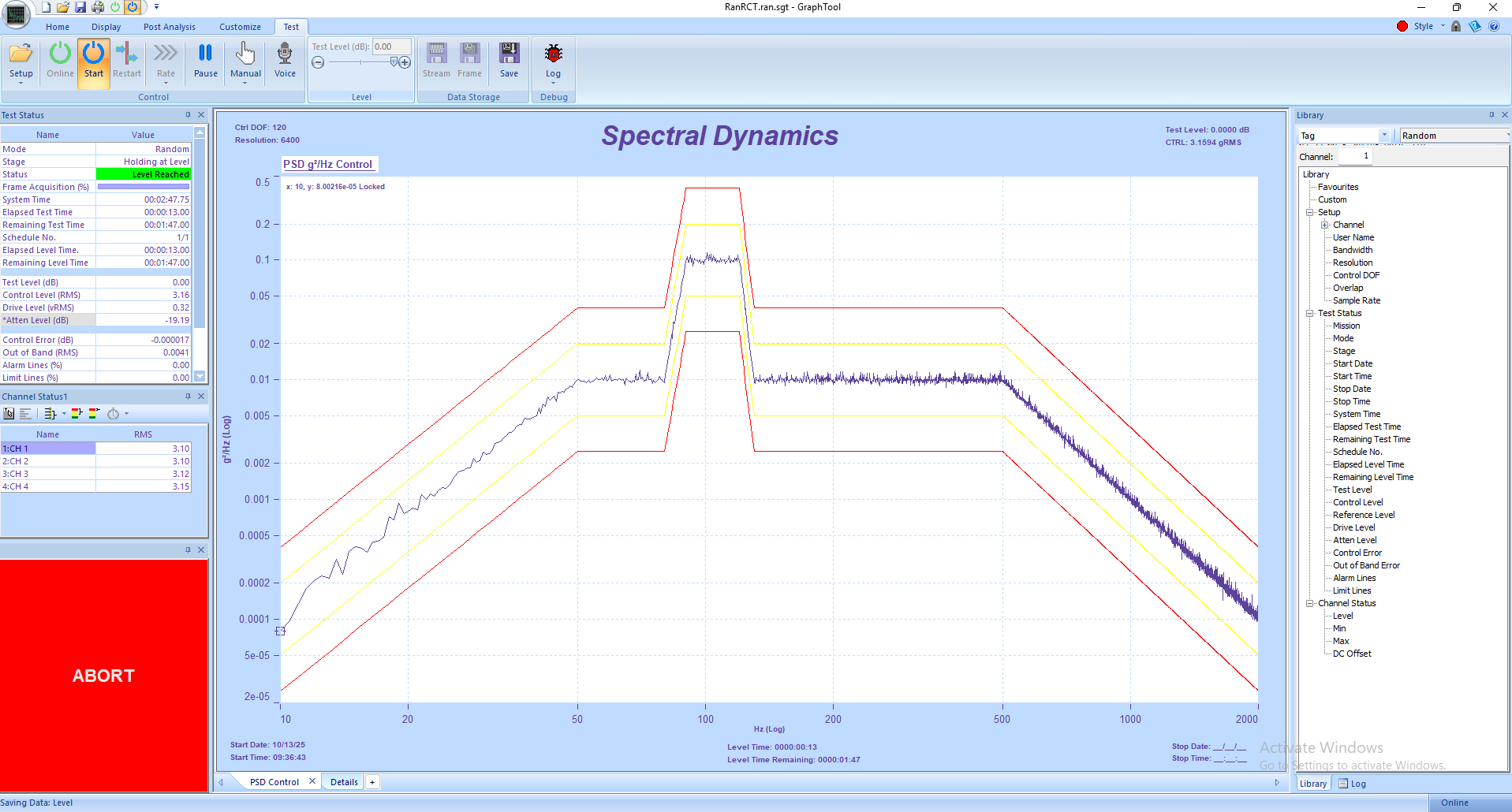Shock Vibration Tutorial
How to Run a Basic Shock Vibration Test on the Panther Control System
1. Safety First
• Shock testing involves high acceleration levels and rapid transients—ensure all personnel are clear of the test area before arming the system.
• Inspect all cables, sensors, and mechanical fixtures for tightness and integrity. Loose components can become projectiles during shock events.
• Verify that the shaker, impact mechanism, and amplifier are properly rated for the intended SRS profile or pulse waveform.
• Confirm that all accelerometers are securely mounted, correctly oriented, and TEDS identified to ensure accurate data capture.
• Ensure all emergency shutdowns (Abort, Stop, and EPO) are clearly accessible and tested before the run.
• Panther continuously monitors more than a dozen safety parameters up to 25 times per second. Its real-time abort logic instantly halts any unsafe condition to protect the test article, shaker, and personnel.
2. System Setup
1. Power on the Panther system and the shaker amplifier, leaving the amplifier in standby until ready.
2. Launch the Panther Shock control application on the host computer.
3. If not already connected to the hardware, navigate via the Setup→ Set Input Type menu in the Panther software to establish hardware connection.
4. Verify that all required input channels are active, properly calibrated, and within safe voltage ranges. Panther’s internal NIST-referenced digital calibration ensures precise results.
5. Select the output channel driving the amplifier input and confirm correct polarity.
6. Open an existing shock setup using the Library feature or create a new one. The Library allows alias-based access to simplify file organization and test recall.
3. Defining the Shock Test
1. In the Control tab, select the Shock or SRS (Shock Response Spectrum) test type.
2. Choose the desired shock type (Half-sine, Trapezoidal, Sawtooth, or User-defined).
3. Set the SRS spectrum or waveform parameters including amplitude, duration, and frequency range.
4. Assign control and monitor accelerometers. Verify proper units (g peak) and sensitivity calibration.
5. Enable pre-test verification to allow Panther to perform a dry run, confirming system readiness and signal integrity before full power.
6. Define abort limits for acceleration, velocity, and displacement to ensure safe operation. Panther’s safety algorithms will automatically halt the test if limits are exceeded.
7. Select the appropriate drive filter and sampling rate (up to 262,144 samples/sec) for accurate waveform generation and control.
8. For synthesized shocks, enable Panther’s Adaptive Control to match the target SRS with minimal iteration.
4. Running the Test
1. Set the amplifier to ‘Operate’ mode once the system passes pre-test checks.
2. Press Start in the GTX toolbar. Panther performs a complete safety validation before generating the drive signal.
3. The waveform is applied in a controlled manner, ensuring accurate time-domain replication and protection of the shaker and DUT.
4. Monitor real-time acceleration, velocity, and displacement traces on the GTX plots. Verify proper trigger timing and peak amplitude.
5. Panther’s closed-loop control continuously adjusts for any deviations, ensuring the achieved pulse matches the target SRS or waveform within tight tolerances.
6. If an unsafe condition is detected, the system automatically aborts the test. The operator can also manually abort using the GTX Abort button.
5. Data Review and Reporting
• Upon completion, Panther automatically saves all transient and control data to the Library for easy access.
• Use GraphtoolX (GTX) for data review. You can playback the transient waveform, overlay control vs. target SRS, and analyze acceleration or velocity time histories.
• Export results directly from GTX to Word, Excel, or PDF using the Share function for reporting.
• Panther allows simultaneous comparison of multiple runs, enabling engineers to confirm consistency between repeated shock events.
6. Panther Advantages in Shock Vibration Testing
• Safety-First Design: Real-time safety monitoring with auto-abort protection ensures safe, controlled operation during high-energy events.
• High-Fidelity Sampling: 24-bit ADCs and 262 kHz sample rates capture shock transients with exceptional accuracy and dynamic range (>110 dB).
• Adaptive Control: Proprietary algorithms adjust the output waveform to precisely match the desired SRS or time waveform without manual iteration.
• Ease of Use: Simple, graphical GTX interface supports both beginners and experts with intuitive test setup and result visualization.
• Real-Time Streaming: Continuous, gap-free data recording ensures no loss of transient detail for analysis.
• Data Integrity: Automatic NIST-traceable calibration and synchronized sampling across all channels (<1° phase match to 100 kHz).
7. Best Practices
• Perform a low-level verification run before applying full test levels to confirm correct setup and safety thresholds.
• Use Panther’s built-in transient preview mode to validate waveform shape and amplitude before engaging the amplifier.
• Verify accelerometer mounting torque and cable routing before every test.
• Review control channel performance post-test using GTX to ensure that achieved shock levels match the target SRS within acceptable limits.
• Regularly back up calibration constants and Library files to maintain traceability and repeatability.











